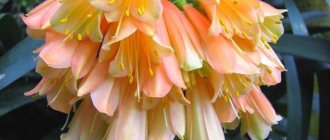It is no coincidence that Cereuses are considered one of the most common indoor and greenhouse cacti. Combining ease of growing with classic forms, cereus allows everyone to find their favorite. In trendy succulent gardens, modest little pots, deserted florariums, these minimally watered cacti are a reliable choice for succulent fans and for those who want to decorate the interior with plants, but are not ready to devote special attention to them.
Cereus are the ideal cacti for the lazy. © fvk1994
Cereus varieties
There are many types of cereus plants:
- Validus. The bluish stem and snow-white flowers of Cereus look very harmonious and aesthetically pleasing.
- Carnegia - its homeland is located in the desert American states, and the flower of this plant is a symbol of Arizona. This cactus produces reddish edible fruits. Cristata is a cactus native to Peru. Its trunks are spherical and grow tightly in relation to each other. Small spines grow from the ribs.
- Azureocereus. Its azure shade immediately attracts attention, as well as its fairly large stem with significant branching. One of the features of this variety of cereus is the corollas, which emit a strong aroma.
Characteristics and birthplace of the flower
Cereus is a very ancient and extensive genus of cacti. It unites many varieties and more than fifty species. In nature, these plants are common in India, South and Central America.
In nature, a flower can reach more than 17-20 meters in height , and its growing season lasts about three hundred years.
Cereus has a long, branched cylindrical covered with numerous spines. There are low types, tall ones, and also creeping ones (those that cling while growing with the help of aerial roots). The cactus grows in hot areas, is adapted to arid climates and can survive for a long time without moisture .
Optimal lighting
You need to make sure there is sufficient lighting for the succulent. But you shouldn’t overdo it - he should get used to the light gradually.
Place at a distance from a source of natural light, direct rays should not fall on the plant, then gradually move the cactus towards the window. Cereus thrives in any temperature (but don't put it in the refrigerator).
The most comfortable temperature for this exotic plant in winter is up to twelve degrees. In summer, this temperature reaches thirty degrees. It is better if the plant lives in a room whose windows are located on the south or southeast side. In the summer, take the cereus out to the balcony.
Description of the plant
Cereuses grow naturally in Central and South America, as well as the West Indies. But not all species of cereus are giants; there are also low-growing and even creeping ones that cling to the ground with the help of shoots. But still, it is the tall species that are better known. It is not for nothing that the name of the genus is translated from Latin as “wax candle”.
Cereus has a cylindrical trunk and stems; dark spines stand out against their green background, which are not very long in relation to the size of the plant, but very dense and rigid.
Large stems are able to accumulate water, which helps not only the cacti themselves, but also birds and animals survive dry periods.
By the way! During severe droughts, farmers give their livestock juicy cactus pulp instead of water.
Under natural conditions, cereus flowers bloom regularly from May to July. Flowers can be located either along the entire stem or only at the top. Flowering is nocturnal, each flower usually lasts only a day, very rarely two. But the abundance of buds and their alternate opening guarantee the duration of the overall flowering.
The core of the flowers is yellow, and the petals can be different shades of white, cream or pink. Their aroma is pleasant, reminiscent of vanilla, but very strong.
Important! If cereus blooms in an apartment, it is not recommended to leave them in the bedroom overnight so that the strong smell does not give you a headache. An increase in blood pressure is also possible.
After flowering, cereus plants produce fairly large oblong or round fruits that can be used as food. They are usually red in various shades.
Replanting a cactus
A cactus that is up to three years old must be replanted every year. In this case, you need to prepare a larger container for transplantation. If the cereus is older, it should be replanted every two to three years. If your plant has reached a height of half a meter, replant it at your discretion, it is important to replace the surface layer of soil each time.
Kinds
Despite the wide variety of species, only a small part is suitable for home cultivation.
Peruvian
The most common species in culture.
It is a plant with a tall, powerful, fleshy, gray-green stem, branching at the very base.
Young shoots are juicy, green-blue in color and have a waxy coating. With age, the shoots become woody.
The stem is divided into 5-8 ribs , along which areoles with red-brown spines are located.
In nature it can reach more than 12 meters in height , in home culture no higher than 3-4 meters.
According to the modern classification, Cereus Repandus, which many biologists considered a separate species, is synonymous with the cactus Cereus Peruvian.
Yamakaru
A tree-like cactus with a fairly powerful, dense, fleshy stem, branched at the very base. Reaches half a meter in height . The stem is endowed with high ribs, which become tuberous with age.
The areoles may be yellowish or brown. Radial and central spines are long, up to 8-10 cm in length.
Cereus yamakaru flowers , greenish-white, and bloom at night .
Uruguayan
A plant with a columnar stem, reaching fifteen meters in height and one and a half meters in diameter.
The stem is endowed with 5-8 ribs with a waxy bluish coating. Covered with numerous, sharp, brown spines 1.5-2 cm long .
Blooms late. The flowers are beautiful, large, 13-15 cm in diameter , red on the outside and white on the inside. The species has excellent drought tolerance.
Monstrous (rocky)
A plant with a very unusual, bizarre shape, which attracts attention. Endowed with branching green-blue stems and unequal ribs that form intricate figures.
On the randomly located ribs and tubercles there are areoles with spiny and needle-shaped spines of brown color.
In its natural environment, the cactus can reach 5 meters in height. At home it grows slowly.
The height of an adult plant reaches 1-1.5 meters .
This species prefers a warm winter. Some flower growers believe that this species belongs to the monstrous form of Cereus Peruvian.
Strauss
A cactus with a graceful stem in the shape of a straight column. The top is completely covered with numerous, light, thin spines. Blooms late. The special shape of the stem helps to better store moisture and do without it for a long time. The plant's homeland is the semi-deserts of America .
Below in the video you can learn more about the variety of Cereus species
How do Cereus reproduce?
Both seeds and cuttings are suitable for this purpose. If you choose the first method, you should start planting the seeds in the spring, and pour a thin layer of sand, slightly moistened with water, on top. Place the workpiece where the temperature is from twenty-two degrees.
To create the necessary humidity, cover the top with a piece of glass or plastic. If your choice is cuttings, take the strongest one and separate it with a knife. First dip the knife into boiling water.
Ventilate tissue defects on the stem in the air for two days. After planting, the cuttings produce roots after four to six weeks. Water with a small amount of water.
Reproduction
In nature, cereus, as a rule, reproduce by seeds. But a vegetative method is also possible, when fragments of stems fall to the ground and take root.
At home, on the contrary, the most common method is cuttings.
Reference! Young segments take root best.
You should proceed like this:
- Manually very carefully break off the segments.
- Dry them so that a crust forms at the break point.
- Pour regular cactus soil into the pots, without compacting it, moisten it.
- Stick the broken segments into the ground without going too deep.
After two to four weeks, the cuttings will take root and the cacti will begin to grow.
Important! The best time for vegetative propagation of cacti is from April to mid-July.
At home, you can grow cereus from seeds. To do this you need:
- Fill wide, low containers with cactus potting mix.
- Moisten with a spray bottle.
- Scatter the seeds over the surface.
- Cover with film or place in a greenhouse.
- When seedlings appear, they are thinned out with tweezers.
Important! You can plant cacti when spines appear on them.
Seeds are sown in spring. Seeds must be germinated at a temperature of 22 °C. Wet the soil when it begins to dry out and only with a fine spray bottle (overmoistening is unacceptable). Lighting needs to be diffused.
Diseases affecting Cereus
Problems can arise with excessive humidity and during cold periods. Adequate drainage is also important.
Recommendations
- Hecht, Hans (1997). Cacti and succulents
. Sterling Pub. Co. p. 76. ISBN 978-0-8069-0549-5. - Teresa M. Chen (2009). A Soup Tradition: Flavors of China's Pearl River Delta
. North Atlantic books. p. 122. ISBN 978-1-55643-765-6. - Daniel E. Moerman (2010). Native American Food Plants: An Ethnobotanical Dictionary
. Timber Press. paragraph 73. ISBN 978-1-60469-189-4.
- Night flowering of Cereus from bud to flowering documentation over a 33-day period
Major pests
Felt. If you see a white coating similar to cotton wool on your indoor cactus, immediately start spraying your pet with a solution of soap and alcohol or Aktellika, Fitoverma.
Spider mite. You may see small defects on the leaves, as well as cobwebs. To prevent the process from falling off, use Actellik and sulfur powder; you can wash the plant first.
Shield. Yellowish spots, sticky drops on the foliage. To prevent the leaves from drying out, use a solution of soap and alcohol, garlic infusion, Fitoverm, Fufanon.
All these tips will help you grow a beautiful unusual plant. It will decorate your home and create a cozy atmosphere. And you can also take a great photo of the cereus and show it to your friends. Caring for plants is real work, and you can get a lot of joy from this rewarding process.
2. Chamecereus care at home
2.1. Temperature conditions
In spring and summer, they are kept at a temperature of 18 - 25 ° C. For abundant flowering in the winter months, plants are immersed in a cool dormant period, which should take place at a temperature of 8 - 10 ° C.
2.2.Lighting
The plants are photophilous and will enjoy direct sunlight in the morning and evening hours. Give cacti some shade on hot summer days. In autumn and winter it is worth providing the most illuminated place.
Chamecereus is hardy and forgives some mistakes of novice gardeners.
2.5.Feeding
During the period of active growth, feed with water-soluble fertilizers for cacti and succulent plants at half strength, monthly. During the dormant period, fertilizing is not carried out.
2.6.Purpose
Low-growing, indoor-flowering plants for well-lit areas. Chamoecereus in lodging stems look great in a hanging basket.
Late spring – early summer.
2.8.Air humidity
Does not require spraying. During the fall and winter, keep the cactus in a dry atmosphere and provide it with sufficient air movement without cold drafts.
2.9.Soil moisture
Water abundantly, completely soaking the soil with moisture, dry the top layer of the substrate to a depth of 2 - 3 cm before each subsequent watering. During the fall, the frequency of watering is gradually reduced and during the winter months the plants should be in almost dry soil. Slightly shriveled stems will indicate the need for watering at this time.
2.10.Transfer
Since this cactus has a shallow root system, you can choose wide bowls for planting. Transplantation is carried out in the spring, annually
Transplanted plants are watered with caution
2.11.Reproduction
Stem cuttings of Chamecereus easily take root even for novice cactus growers, in spring and summer in wet sand. The place where the cuttings are cut is dried for several days before planting. Seeds.
2.12.Pests and diseases
Like most cacti, it rots easily if there is excess moisture, especially during the dormant period. When grown in partial shade, plants become elongated and unsightly.
Red mites, mealybugs, thrips and aphids sometimes appear.
Insects - pests
| Insect name | Signs of infection | Control measures |
| Mealybug or feltworm | The surface of the leaves and shoots is covered with a fluffy, cotton-like white coating. Plants lag behind in development | Folk remedies: spraying with soap and alcohol solution. Infusions of tobacco, garlic, cyclamen tubers, alcohol treatments, and pharmacy tincture of calendula have worked well. Chemicals: green soap solution, Actellik, Fitoverm. |
| Spider mite | Inconspicuous cobwebs on the leaves, yellowing and falling leaves with extensive damage. The surface of the leaf plates becomes dead and covered with small cracks. Plant development slows down. | Folk methods. Plants can be washed in the shower and left in the bathroom in a humid atmosphere for half an hour. Irradiation with an ultraviolet lamp every week for 2 minutes. Chemical preparations based on pyrethrum, sulfur powders, Fitoverm, Actellik. |
| Aphid | Sticky droplets appear on the leaf blades, the leaf blades curl and become deformed, tender buds and young leaves wither. Colonies of insects can be seen on the tips of shoots, buds or the underside of leaf blades. The flowers of plants affected by aphids may become deformed. | Folk methods: nettle infusion, decoction of rhubarb leaves, wormwood, soap solution, infusion of tobacco and dandelion, onion, marigold, yarrow, tansy, dusting with wood ash. Chemicals: Sulfur powders, treatment of green mass with green potassium soap without getting into the ground, Decis, Actellik, Fitoverm. |
| Trips | The appearance of yellow spots on the leaf blades; small brown dots can be observed on the underside of the leaves. When pests spread, they cause leaves to turn yellow, dry out and fall off. | Folk methods. Increase air humidity, wipe the surface of the leaves with a soap solution to reduce the number of pests. Preparations based on pyrethrum - 2-fold treatment with an interval of 7 - 10 days, spraying with tobacco infusion, infusion of yarrow or Persian chamomile, decoction of cyclamen tubers. Chemical preparations: dusting with sulfur powders, using anabasine sulfate in a soap solution. |
- Mealybug or feltworm
- Spider mite
- Aphid
- Trips
2.13.Note
Young shoots can easily break off from the main plant when transplanted.
Hydroponics.
You might also be interested in:
Echinopsis
Cylindropuntia
Rebutia
Epiphyllum
Photo of Cereus
Features of flowering
In nature it blooms in May or very early summer. Many species open their flowers at night. Location - lateral, on the lateral parts of the stem. The flowers are large, often white with a yellow center. The smell is strong but pleasant. Flowers of some species emit a vanilla scent.
On a large wild cactus, up to 10 flowers can bloom simultaneously. Flowering does not last long - the flowers fade within a day. It is very difficult to achieve mass flowering in an apartment. It is believed that the flowering of cereus is great luck. But the plant just needs favorable conditions - long daylight hours, the right dormant period. There are several reasons for the lack of flowering:
- Insufficient lighting.
- Lack of a rest period or violation of recommended conditions in winter.
- Young specimens do not bloom.
- Rare ventilation, improper watering regime.
Flowering requires a well-lit place, additional lighting as needed. The plant must receive the right amount of moisture and winter quietly at low temperatures. The timing of flowering in an apartment depends on the conditions of detention. The cactus blooms in late spring, summer or autumn. After flowering, the fruit ripens red or yellow. The size of the fruit is up to 10 cm. The surface is smooth, at the tip there are remains of a flower pistil. The fruit is edible and smells pleasant.











